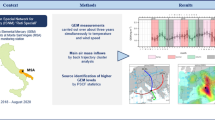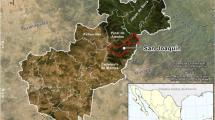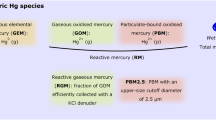Abstract
Within the Global Mercury Observation System (GMOS) project, long-term continuous measurements of total gaseous mercury (TGM) were carried out by a monitoring station located at Celestun, Yucatan, Mexico, a coastal site along the Gulf of Mexico. The measurements covered the period from January 28th to October 17th, 2012. TGM data, at the Celestun site, were obtained using a high-resolution mercury vapor analyzer. TGM data show values from 0.50 to 2.82 ng/m3 with an annual average concentration of 1.047 ± 0.271 ng/m3. Multivariate analyses of TGM and meteorological variables suggest that TGM is correlated with the vertical air mass distribution in the atmosphere, which is influenced by diurnal variations in temperature and relative humidity. Diurnal variation is characterized by higher nighttime mercury concentrations, which might be influenced by convection currents between sea and land. The back trajectory analysis confirmed that local sources do not significantly influence TGM variations. This study shows that TGM monitoring at the Celestun site fulfills GMOS goals for a background site.








Similar content being viewed by others
References
Arcega-Cabrera F, Armienta MA, Daesslé LW, Castillo-Blum SE, Talavera O, Dótor A (2009) Variations of Pb in a mine-impacted tropical river, Taxco, Mexico: use of geochemical, isotopic and statistical tools. Appl Geochem 24:162–171
Arcega-Cabrera F, Noreña-Barroso E, Oceguera-Vargas I (2014) Lead from hunting activities and its potential environmental threat to wildlife in a protected wetland in Yucatan, Mexico. Ecotoxicol Environ Saf 100:251–257
Arcega-Cabrera F, Garza-Pérez R, Noreña-Barroso E, Oceguera-Vargas I (2015) Impacts of geochemical and environmental factors on seasonal variation of heavy metals in a coastal lagoon Yucatan, Mexico. Bull Environ Contam Toxicol 94:58–65
Aspmo K, Berg T, Ferrari C, Gauchard PA, Fain X, Wibetoe G (2006) Mercury in the Atmosphere, Snow and Melt Water Ponds in the North Atlantic Ocean during Arctic Summer. Environ Sci Technol 40:4083–4089
Brosset C (1987) The behavior of mercury in the physical environment. Water Air Soil Pollut 34(2):145–166
Brunke EG, Labuschagne C, Ebinghaus R, Kock HH, Slemr F (2010) Gaseous elemental mercury depletion events observed at Cape Point during 2007–2008. Atmos Chem Phys 10(3):1121–1131
Carpi A, Lindberg SE (1998) Application of a teflon dynamic flux chamber for quantifying soil mercury flux: tests and results over background soil. Atmos Environ 32:873–882
De La Rosa DA, Volke-Sepulveda T, Solorzano G, Green C, Tordon R, Beauchamp S (2004) Survey of atmospheric total gaseous mercury in Mexico. Atmos Environ 38:4839–4846
Draxler, R R (1999) HYSPLIT4 User’s Guide, NOAA Tech. Memo, ERLARL-230, NOAA Air Resources Laboratory, Silver Spring. Last revised April 2013
Fritz B, Matthew Barnett J, Snyder S, Bisping L, Rishel J (2015) Development of criteria used to establish a background environmental monitoring station. J Environ Radioact 143:52–57
Fu X, Feng X, Zhu W, Wang S, Lu J (2008) Total gaseous mercury concentrations in ambient air in the eastern slope of Mt. Gongga, South-Eastern fringe of the Tibetan plateau, China. Atmos Environ 42(5):970–979
Fu XW, Feng X, Liang P, Zhang H, Ji J, Liu P (2012) Temporal trend and sources of speciated atmospheric mercury at Waliguan GAW station, Northwestern China. Atmos Chem Phys 12(4):1951–1964
García R, C del Torres Ma, Padilla H, Belmont R, Azpra E, Arcega-Cabrera F, Báez A (2006) Measurements of the trace metals and inorganic ions in Rancho Viejo a rural wooded area in the state of Mexico, Mexico. Atmos Environ. 40(32):6088–6100
Global Mercury Observation System (GMOS) (2013) Institute of Atmospheric Pollution Research, Italy and European Commission., http://www.gmos.eu/
Iverfeldt Å (1991) Occurrence and turnover of atmospheric mercury over Nordic countries. Water Air Soil Pollut 56(2013):251–265
Kellerhals M, Beauchamp S, Belzer W, Blanchard P, Froude F, Harvey B, Tordon R (2003) Temporal and spatial variability of total gaseous mercury in Canada: results from the Canadian Atmospheric Mercury Measurement Network (CAMNet). Atmos Environ 37(7):1003–1011
Kennett RJ, Korb KB, Nicholson AE (2001) Seabreeze prediction using Bayesian networks. In: Advances in Knowledge Discovery and Data Mining. Springer, Berlin, pp 148–153
Kim M-Y, Kang H-G, Park S-B (1987) Study of the distribution and behavior of mercury in ambient air. J Korean Air Pollut Res Assoc 13(2):9–24
Kock HH, Bieber E, Ebinghaus R, Spain TG, Thees B (2005) Comparison of long-term trends and seasonal variations of atmospheric mercury concentrations at the two European coastal monitoring stations Mace Head, Ireland, and Zingst, Germany. Atmos Environ 39(39):7549–7556
Lee DS, Dollard GJ, Pepler S (1998) Gas-phase mercury in the atmosphere of the United Kingdom. Atmos Environ 32:855–864
Lindberg S, Bullock R, Ebinghaus R, Engstrom D, Feng XB, Fitzgerald W, Pirrone N, Prestbo E, Seigneur C (2007) A synthesis of progress and uncertainties in attributing the sources of mercury in deposition. Ambio 36(1):19–32
Lindqvist O, Rodhe H (1985) Atmospheric mercury—a review. Tellus B 37(3):136–159
Lu JY, Schroeder WH (2004) Annual time-series of total filterable atmospheric mercury concentrations in the Arctic. Tellus 56B:213–222
Marquez-Estrada (2011) Characterization of the Celestún site: meteorology and potential mercury sources. Technical Report of Celestún
Mason RP, Reinfelder JR, Morel FMM (1995) Bioaccumulation of mercury and methylmercury. Water Air Soil Pollut 80(1-4):915–921
Petersen G, Iverfeldt Å, Munthe J (1995) Atmospheric mercury species over central and northern Europe; model calculations and comparison with observations from the Nordic air precipitation network for 1987 and 1988. Atmos Environ 29:47–67
Pirrone N, Mason RP (eds) (2009) Mercury fate and transport in the global atmosphere: emissions, measurements and models. Springer, Berlin
Poissant L (2000) Total gaseous mercury in Québec (Canada) in 1998. Sci Total Environ 259:191–201
Schmolke SR, Schroeder WH, Kock HH, Schneeberger D, Munthe J, Ebinghaus R (1999) Simultaneous measurements of total gaseous mercury at four sites on a 800 km transect: spatial distribution and short-time variability of total gaseous mercury over central Europe. Atmos Environ 33:1725–1733
Schroeder WH, Munthe J (1998) Atmospheric mercury an overview. Atmos Environ 32:809–822
SEDUMA-Yucatán (Secretaria de Desarrollo Urbano y Medio Ambiente del Estado de Yucatán) (2009) Programa estatal para la prevención y gestión integral de los residuos 2009-2012. Gobierno del Estado de Yucatán, México, p 125, Available in: http://www.semarnat.gob.mx/sites/default/files/documentos/gestionresiduos/pepgir_yucatan.pdf
Soler-Bientz R, Watson S, Infield D (2010) Wind characteristics on the Yucatán Peninsula based on short term data from meteorological stations. Energy Conversion Manag 51:754–764
Sprovieri F, Pirrone N, Ebinghaus R, Kock H, Dommergue A (2010) A review of worldwide atmospheric mercury measurements. Atmos Chem Phys 10(17):8245–8265
Sprovieri F, Gratz LE, Pirrone N (2013) Development of a Ground-Based Atmospheric Monitoring Network for the Global Mercury Observation System (GMOS). In: E3S Web of Conferences, Vol. 1, 17007. EDP Sciences
Stamenkovic J, Lyman S, Gustin MS (2007) Seasonal and diel variation of atmospheric mercury concentrations in the Reno (Nevada, USA) airshed. Atmos Environ 41(31):6662–6672
Temme C, Einax JW, Ebinghaus R, Schroeder WH (2003) Measurements of atmospheric mercury species at a coastal site in the Antarctic and over the south Atlantic Ocean during polar summer. Environ Sci Technol 37:22–31
UNEP (2013) Global Mercury Assessment 2013: sources, emissions, releases and environmental transport. UNEP Chemicals Branch, Geneva
Wan Q, Feng X, Lu J, Zheng W, Song X, Han S, Xu H (2009) Atmospheric mercury in Changbai Mountain area, northeastern China I. The seasonal distribution pattern of total gaseous mercury and its potential sources. Environ Res 109:201–206
Wang Z-W, Chen Z-S, Duan N, Zhang X-S (2007) Gaseous elemental mercury concentration in atmosphere at urban and remote sites in China. J Environ Sci 19:176–180
Weiss-Penzias P, Jaffe DA, Mcclintick A (2003) Gaseous elemental mercury in the marine boundary layer: evidence for rapid removal in anthropogenic pollution. Environ Sci Tech 37:3755–3763
Zhu J, Wang T, Talbot R, Mao H, Hall CB, Yang X, Huang X (2012) Characteristics of atmospheric total gaseous mercury (TGM) observed in urban Nanjing, China. Atmos Chem Phys 12(24):12103–12118
Acknowledgments
We would like to especially thank Nicola Pirrone, the director of the GMOS project, and his collaborator Francesca Sprovieri for their great support and the guidance they have provided for our work. We would also like to thank the DUMAC staff, from both Merida and Celestun, for their contributions in the management of the measuring station. This project received funding from the European Union’s Seventh Programme for Research, Technological Development, and Demonstration under grant agreement No. 265113.
Author information
Authors and Affiliations
Corresponding author
Additional information
Responsible editor: Philippe Garrigues
Rights and permissions
About this article
Cite this article
Velasco, A., Arcega-Cabrera, F., Oceguera-Vargas, I. et al. Global Mercury Observatory System (GMOS): measurements of atmospheric mercury in Celestun, Yucatan, Mexico during 2012. Environ Sci Pollut Res 23, 17474–17483 (2016). https://doi.org/10.1007/s11356-016-6852-5
Received:
Accepted:
Published:
Issue Date:
DOI: https://doi.org/10.1007/s11356-016-6852-5




